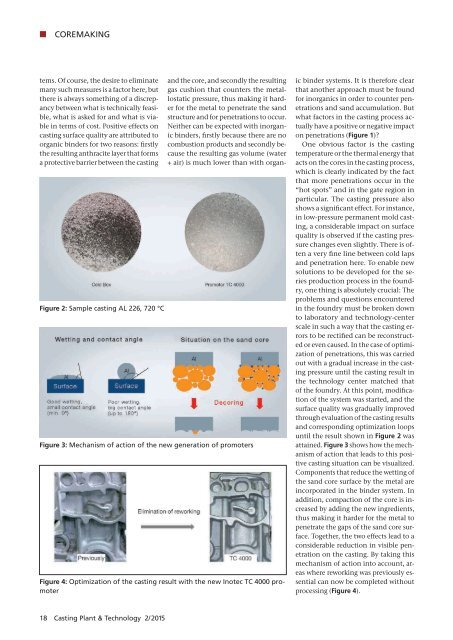CPT International 02/2015
The leading technical journal for the global foundry industry – Das führende Fachmagazin für die weltweite Gießerei-Industrie
The leading technical journal for the
global foundry industry – Das führende Fachmagazin für die
weltweite Gießerei-Industrie
Create successful ePaper yourself
Turn your PDF publications into a flip-book with our unique Google optimized e-Paper software.
K COREMAKING<br />
tems. Of course, the desire to eliminate<br />
many such measures is a factor here, but<br />
there is always something of a discrepancy<br />
between what is technically feasible,<br />
what is asked for and what is viable<br />
in terms of cost. Positive effects on<br />
casting surface quality are attributed to<br />
organic binders for two reasons: firstly<br />
the resulting anthracite layer that forms<br />
a protective barrier between the casting<br />
Figure 2: Sample casting AL 226, 720 °C<br />
Figure 3: Mechanism of action of the new generation of promoters<br />
Figure 4: Optimization of the casting result with the new Inotec TC 4000 promoter<br />
and the core, and secondly the resulting<br />
gas cushion that counters the metallostatic<br />
pressure, thus making it harder<br />
for the metal to penetrate the sand<br />
structure and for penetrations to occur.<br />
Neither can be expected with inorganic<br />
binders, firstly because there are no<br />
combustion products and secondly because<br />
the resulting gas volume (water<br />
+ air) is much lower than with organic<br />
binder systems. It is therefore clear<br />
that another approach must be found<br />
for inorganics in order to counter penetrations<br />
and sand accumulation. But<br />
what factors in the casting process actually<br />
have a positive or negative impact<br />
on penetrations (Figure 1)?<br />
One obvious factor is the casting<br />
temperature or the thermal energy that<br />
acts on the cores in the casting process,<br />
which is clearly indicated by the fact<br />
that more penetrations occur in the<br />
“hot spots” and in the gate region in<br />
particular. The casting pressure also<br />
shows a significant effect. For instance,<br />
in low-pressure permanent mold casting,<br />
a considerable impact on surface<br />
quality is observed if the casting pressure<br />
changes even slightly. There is often<br />
a very fine line between cold laps<br />
and penetration here. To enable new<br />
solutions to be developed for the series<br />
production process in the foundry,<br />
one thing is absolutely crucial: The<br />
problems and questions encountered<br />
in the foundry must be broken down<br />
to laboratory and technology-center<br />
scale in such a way that the casting errors<br />
to be rectified can be reconstructed<br />
or even caused. In the case of optimization<br />
of penetrations, this was carried<br />
out with a gradual increase in the casting<br />
pressure until the casting result in<br />
the technology center matched that<br />
of the foundry. At this point, modification<br />
of the system was started, and the<br />
surface quality was gradually improved<br />
through evaluation of the casting results<br />
and corresponding optimization loops<br />
until the result shown in Figure 2 was<br />
attained. Figure 3 shows how the mechanism<br />
of action that leads to this positive<br />
casting situation can be visualized.<br />
Components that reduce the wetting of<br />
the sand core surface by the metal are<br />
incorporated in the binder system. In<br />
addition, compaction of the core is increased<br />
by adding the new ingredients,<br />
thus making it harder for the metal to<br />
penetrate the gaps of the sand core surface.<br />
Together, the two effects lead to a<br />
considerable reduction in visible penetration<br />
on the casting. By taking this<br />
mechanism of action into account, areas<br />
where reworking was previously essential<br />
can now be completed without<br />
processing (Figure 4).<br />
18 Casting Plant & Technology 2/<strong>2015</strong>


















